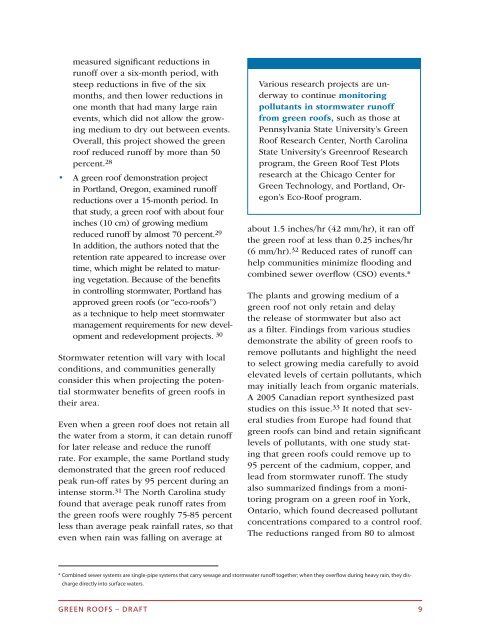Reducing Urban Heat Islands: Compendium of Strategies - Green ...
Reducing Urban Heat Islands: Compendium of Strategies - Green ...
Reducing Urban Heat Islands: Compendium of Strategies - Green ...
You also want an ePaper? Increase the reach of your titles
YUMPU automatically turns print PDFs into web optimized ePapers that Google loves.
measured signifcant reductions in<br />
run<strong>of</strong>f over a six-month period, with<br />
steep reductions in fve <strong>of</strong> the six<br />
months, and then lower reductions in<br />
one month that had many large rain<br />
events, which did not allow the growing<br />
medium to dry out between events.<br />
Overall, this project showed the green<br />
ro<strong>of</strong> reduced run<strong>of</strong>f by more than 50<br />
percent. 28<br />
• A green ro<strong>of</strong> demonstration project<br />
in Portland, Oregon, examined run<strong>of</strong>f<br />
reductions over a 15-month period. In<br />
that study, a green ro<strong>of</strong> with about four<br />
inches (10 cm) <strong>of</strong> growing medium<br />
reduced run<strong>of</strong>f by almost 70 percent. 29<br />
In addition, the authors noted that the<br />
retention rate appeared to increase over<br />
time, which might be related to maturing<br />
vegetation. Because <strong>of</strong> the benefts<br />
in controlling stormwater, Portland has<br />
approved green ro<strong>of</strong>s (or “eco-ro<strong>of</strong>s”)<br />
as a technique to help meet stormwater<br />
management requirements for new development<br />
and redevelopment projects. 30<br />
Stormwater retention will vary with local<br />
conditions, and communities generally<br />
consider this when projecting the potential<br />
stormwater benefts <strong>of</strong> green ro<strong>of</strong>s in<br />
their area.<br />
Even when a green ro<strong>of</strong> does not retain all<br />
the water from a storm, it can detain run<strong>of</strong>f<br />
for later release and reduce the run<strong>of</strong>f<br />
rate. For example, the same Portland study<br />
demonstrated that the green ro<strong>of</strong> reduced<br />
peak run-<strong>of</strong>f rates by 95 percent during an<br />
intense storm. 31 The North Carolina study<br />
found that average peak run<strong>of</strong>f rates from<br />
the green ro<strong>of</strong>s were roughly 75-85 percent<br />
less than average peak rainfall rates, so that<br />
even when rain was falling on average at<br />
Various research projects are underway<br />
to continue monitoring<br />
pollutants in stormwater run<strong>of</strong>f<br />
from green ro<strong>of</strong>s, such as those at<br />
Pennsylvania State University’s <strong>Green</strong><br />
Ro<strong>of</strong> Research Center, North Carolina<br />
State University’s <strong>Green</strong>ro<strong>of</strong> Research<br />
program, the <strong>Green</strong> Ro<strong>of</strong> Test Plots<br />
research at the Chicago Center for<br />
<strong>Green</strong> Technology, and Portland, Oregon’s<br />
Eco-Ro<strong>of</strong> program.<br />
about 1.5 inches/hr (42 mm/hr), it ran <strong>of</strong>f<br />
the green ro<strong>of</strong> at less than 0.25 inches/hr<br />
(6 mm/hr). 32 Reduced rates <strong>of</strong> run<strong>of</strong>f can<br />
help communities minimize fooding and<br />
combined sewer overfow (CSO) events.*<br />
The plants and growing medium <strong>of</strong> a<br />
green ro<strong>of</strong> not only retain and delay<br />
the release <strong>of</strong> stormwater but also act<br />
as a flter. Findings from various studies<br />
demonstrate the ability <strong>of</strong> green ro<strong>of</strong>s to<br />
remove pollutants and highlight the need<br />
to select growing media carefully to avoid<br />
elevated levels <strong>of</strong> certain pollutants, which<br />
may initially leach from organic materials.<br />
A 2005 Canadian report synthesized past<br />
studies on this issue. 33 It noted that several<br />
studies from Europe had found that<br />
green ro<strong>of</strong>s can bind and retain signifcant<br />
levels <strong>of</strong> pollutants, with one study stating<br />
that green ro<strong>of</strong>s could remove up to<br />
95 percent <strong>of</strong> the cadmium, copper, and<br />
lead from stormwater run<strong>of</strong>f. The study<br />
also summarized fndings from a monitoring<br />
program on a green ro<strong>of</strong> in York,<br />
Ontario, which found decreased pollutant<br />
concentrations compared to a control ro<strong>of</strong>.<br />
The reductions ranged from 80 to almost<br />
* Combined sewer systems are single-pipe systems that carry sewage and stormwater run<strong>of</strong> together; when they overfow during heavy rain, they discharge<br />
directly into surface waters.<br />
GREEN ROOFS – DRAFT 9

















